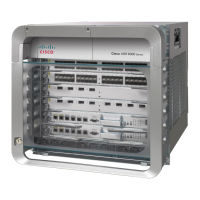40
Cisco ASR 9000 Series Aggregation Services Router Getting Started Guide
OL-28417-02
Chapter Configuring General Router Features
Connecting and Communicating with the Router
6. Press Enter.
7. Log in to the router.
DETAILED STEPS
Command or Action Purpose
Step 1
Install and configure the terminal
server.
Prepares the terminal server for communications with the router and with
Telnet clients.
• This step is usually preformed once.
• For router access, users need the Telnet server IP address and port
number for each they access.
• For additional information on configuring terminal services, including
terminal servers and templates, see .
Step 2
Connect the terminal server to the
Console port of the target .
Establishes a communications path between the terminal server and the
router.
• During the initial router setup, you can communicate with the router
only through the Console port of the primary .
• The router Console port is designed for a serial cable connection to a
terminal or terminal server.
• The terminal settings are:
–
Bits per second: 9600(default value)
–
Data bits: 8
–
Parity: None
–
Stop bit:
–
Flow control: None
• For information on the cable requirements for the Console port, see
the hardware documentation listed in the
“Related Documents”
section on page x.
Step 3
Power on the router. Starts the router.
• This step is required only if the router power is not on.
• For information on power installation and controls, see the hardware
documentation listed in the
“Related Documents” section on page x.
Step 4
Identify the target . Identifies the to which you connect in the next step.
• This step is not required when the router hosts only one .
•
Step 5
telnet access-server-address port
Establishes a Telnet session with the terminal server.
• Replace access-server-address with the IP address of the terminal
server, and replace port with the terminal server port number that
connects to the target Console port.

